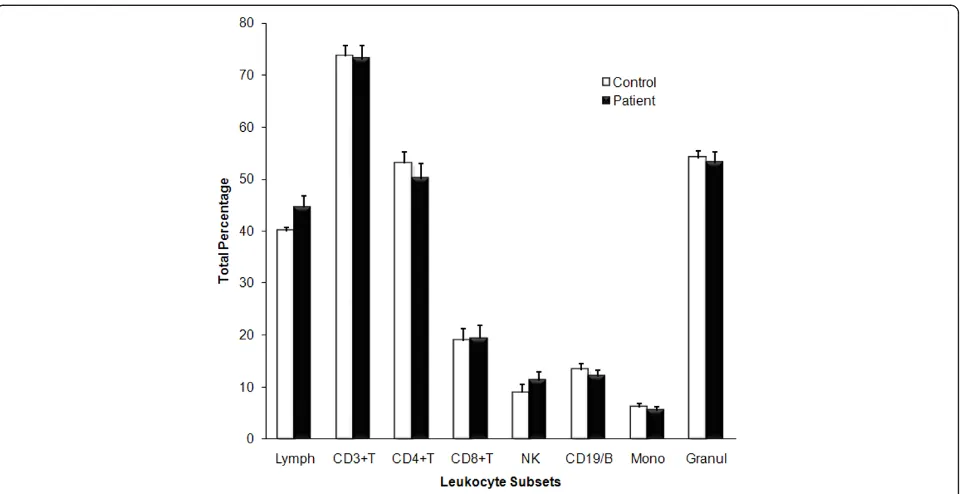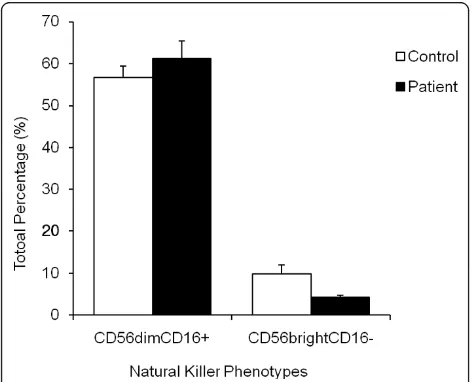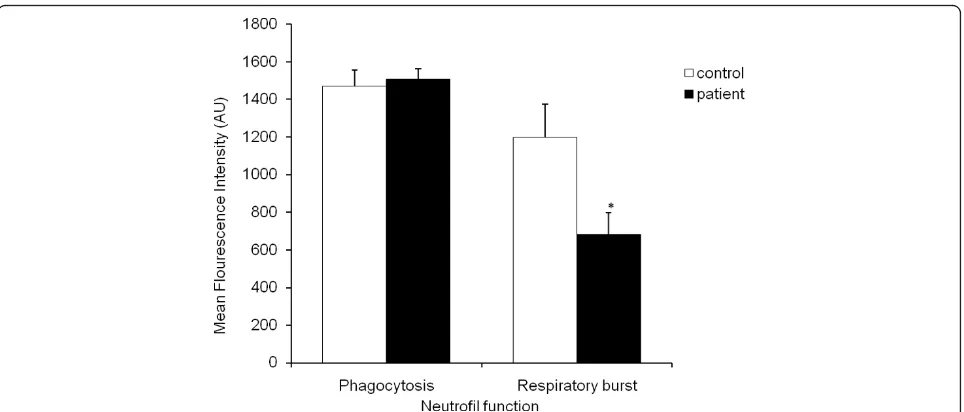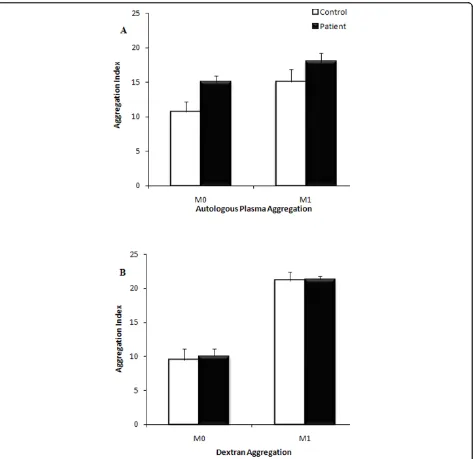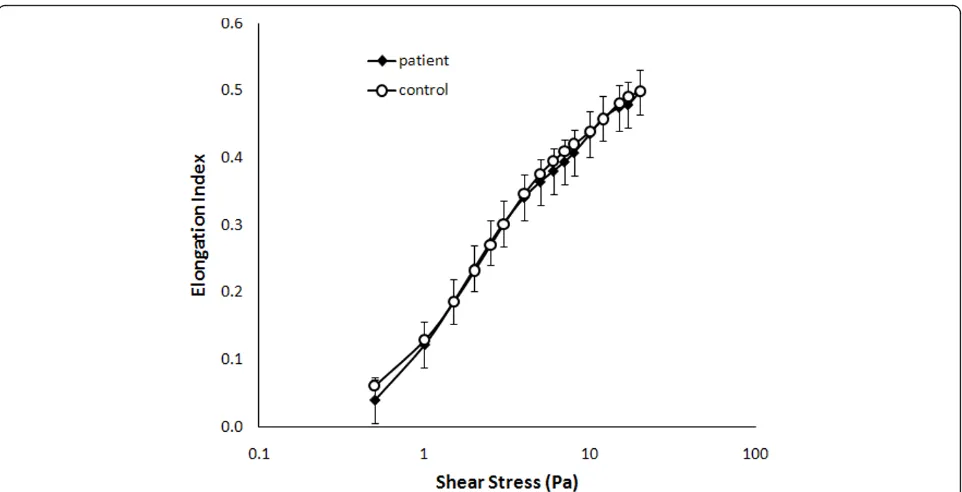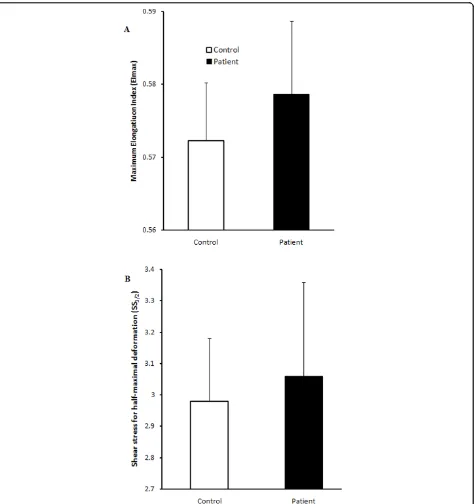R E S E A R C H
Open Access
Immune and hemorheological changes in
Chronic Fatigue Syndrome
Ekua W Brenu
1,2*, Donald R Staines
1,3, Oguz K Baskurt
4, Kevin J Ashton
2, Sandra B Ramos
2, Rhys M Christy
2,
Sonya M Marshall-Gradisnik
1,2Abstract
Background:Chronic Fatigue Syndrome (CFS) is a multifactorial disorder that affects various physiological systems including immune and neurological systems. The immune system has been substantially examined in CFS with equivocal results, however, little is known about the role of neutrophils and natural killer (NK) phenotypes in the pathomechanism of this disorder. Additionally the role of erythrocyte rheological characteristics in CFS has not been fully expounded. The objective of this present study was to determine deficiencies in lymphocyte function and erythrocyte rheology in CFS patients.
Methods:Flow cytometric measurements were performed for neutrophil function, lymphocyte numbers, NK phenotypes (CD56dimCD16+and CD56brightCD16-) and NK cytotoxic activity. Erythrocyte aggregation, deformability and fibrinogen levels were also assessed.
Results:CFS patients (n= 10) had significant decreases in neutrophil respiratory burst, NK cytotoxic activity and CD56brightCD16-NK phenotypes in comparison to healthy controls (n= 10). However, hemorheological
characteristic, aggregation, deformability, fibrinogen, lymphocyte numbers and CD56dimCD16+NK cells were similar between the two groups.
Conclusion:These results indicate immune dysfunction as potential contributors to the mechanism of CFS, as indicated by decreases in neutrophil respiratory burst, NK cell activity and NK phenotypes. Thus, immune cell function and phenotypes may be important diagnostic markers for CFS. The absence of rheological changes may indicate no abnormalities in erythrocytes of CFS patients.
Background
Persistent unrelenting fatigue affects individuals across all ages worldwide and severe forms of prolonged fati-gue may be diagnosed as Chronic Fatifati-gue Syndrome (CFS) usually accompanied by other disabling symp-toms. CFS is a heterogeneous multifactorial disease characterised by severe fatigue and an inability to func-tion at optimal levels [1]. The multifactorial nature of this disease is due to the multiple causal factors asso-ciated with the disorder [2]. CFS by definition is a new onset of prolonged persistent fatigue enduring for over a period of 6 months or more, with the presence of at least four of the following symptoms; impaired short term memory or concentration, sore throat, tender
cervical or auxiliary lymph nodes, multijoint pain with no indication of swelling or redness, severe headaches, unrefreshing sleep and postexertional malaise with a duration of 24 hours or more. Psychiatric disorders such as melancholic depression, substance abuse, bipolar dis-order, psychosis and eating disorders are excluded when diagnosing patients based on this definition [3].
To date, the exact mechanism(s) of CFS remains elu-sive however immune deficiencies particularly in lym-phocytes function and number have been observed as a potential factor. Importantly, consistent decreases in NK cytotoxic activity have been observed among different populations of CFS patients [4-7]. Some studies have suggested that these decreases in NK function may involve low levels of granzymes, perforin proteins and increases in the expression of the granzyme geneGZMA [6,8]. Although NK subsets, have been examined to some extent in CFS [4,9,10], these findings have not
* Correspondence: ebrenu@student.bond.edu.au
1Faculty of Health Science and Medicine, Population Health and Neuroimmunology Unit, Bond University, Robina, Queensland, Australia
necessarily elucidated the role of CD56brightCD16negative
(neg)
NK and CD56dimCD16postive(pos)NK phenotypes in CFS. NK cells and their subsets are important in immune regulation and pathogen lysis. CD56bright
CD16-neg
NK cells preferentially secrete high levels of cyto-kines and have limited cytotoxic function while CD56dimCD16pos NK cells are mainly cytotoxic [11]. Moreover, phagocytes such as neutrophils have received little attention, only one study has revealed that neutro-phils in CFS are more prone to apoptosis, this was heightened by the existence of large quantities of TGFb1[12].
The multifactorial and heterogeneous nature of CFS suggests changes in other blood indicators, such as ery-throcytes. Some CFS patients demonstrate alterations in blood flow, erythrocyte rheology and erythrocyte mor-phology [13-17]. Abnormally shaped erythrocyte may present itself in the form of nondiscocytic, stomatocytic or cup formed erythrocyte [18]. Additionally, reductions in erythrocyte width and mass, and changes in platelet aggregation have also been detected in some CFS patients [13,16]. Plasma proteins such as fibrinogen which influ-ence erythrocyte rheology are elevated in some CFS cases, and this may be related to impaired coagulation [19] however, an association between erythrocyte aggre-gation and fibrinogen levels in CFS is not presently known. Alterations in erythrocyte rheology may persist in CFS, these observations although indicative of indirect changes in deformation and aggregation suggests the need for further investigations to confirm the possible link between immune function and rheology in CFS.
Hence, the objective of this study was to examine immune function and rheological properties of periph-eral blood cells. This study investigated NK abnormal-ities in CFS to confirm those of other studies. NK phenotypes, NK cytotoxic activity, neutrophil function, lymphocyte numbers, fibrinogen levels and erythrocyte rheology were measured in CFS patients. The CFS data were compared to aged and sex matched group of health volunteers.
Materials and methods Participants
The present study was approved by Bond University Ethics Committee (RO852). Collection of venous blood was performed following consent from participants. Informed consent was prepared in accordance with the Bond University Research Consultancy Service and pro-tocol. The CFS cohort comprised of 10 CFS patients from a community based sample in New South Wales and Queensland, Australia and 10 healthy aged and sex matched participants from a community local area. CFS patients were chosen after completion of a questionnaire adapted from the CDC 1994 CFS case definition [3],
where the duration of CFS in our patient cohort was more than 5 years. Peripheral blood samples were ana-lysed for total lymphocytes, NK activity, NK phenotypes, neutrophil function, erythrocyte deformability, erythro-cyte aggregation and fibrinogen concentration.
Lymphocytes assay
Peripheral blood lymphocyte subsets were assessed using fluorochrome-conjugated monoclonal antibodies from the Simultest IMK-Lymphocyte kit (BD Biosciences, San Jose, CA), specific for lymphocytes as previously described [20]. A fluorescence-activated cell sorting (FACS Calibur) flow cytometer (Becton Dickinson Immunocytometry Systems, San Jose, CA) was used to determine lymphocyte subsets, CD3+/CD19 (B cells), CD3+ (T cell), CD3+/Cd4+ (T-helper cells), CD3+/CD8 + (T-cytotoxic, T suppressor), CD3-/CD16+/CD56+ (Natural Killer cells).
Assessment of NK lymphocyte activity
NK cytotoxicity was performed as previously described [21]. Briefly, NK cells were isolated from whole blood via density gradient centrifugation using ficoll-Hypaque (GE Healthcare). NK cells were labelled with 0.4% PKH-26 (Sigma, St Louis, MO). NK cells were resuspended at a final concentration of 5 × 106cells/mL. The K562 cell line was used as the target cells at a concentration of 1 × 105cells/mL. K562 cells were cultured with NK cells in RPMI-1640 culture media (Invitrogen, Carlsbad, CA) for 4 hours in 37°C incubator with 5% CO2, at an
effec-tor (NK) to target (K562) ratio of 25:1 with a control sample containing only K562 cells. Apoptosis was mea-sured via flow cytometry, using Annexin V-FITC conju-gated mAB and 7-AAD reagent (BD Pharmingen, San Diego, CA) according to the manufacturer’s instructions. Percent lysis of K562 cells were calculated as previously described [21].
Quantification of NK phenotypes
To assess the levels of NK phenotypes in CFS patients and healthy controls, NK lymphocytes were isolated from whole blood according to manufacturer’s instruc-tions using RosetteSep Human Natural Killer cell Enrichment Cocktail (StemCell Technologies, Vancou-ver, BC), containing micro-beads that negatively select for only NK cells and ficoll-hypaque density centrifuga-tion. Samples were washed twice with PBS and labelled with mAB CD56-FITC (BD Bioscience, San Jose, CA) and CD16-PE (BD Bioscience, San Jose, CA) according to manufacturer’s specifications and analysed on flow cytometer.
Neutrophil function test
manufacturer. In summary, to determine phagocytosis, blood samples were mixed with FITC-labelled opsonised E.coli and incubated for 10 minutes in 37°C water bath or on ice at 0°C. Quenching solution was added to remove the FITC from theE.coli. Intracellular oxidation was performed by incubating heparinised whole blood in phorbol 12-myristate 13-acetate (PMA) for 10 min-utes at 37°C. Dihydrohodamine (DHR) was then added to the samples followed by an incubation period of 10 minutes at 37°C. DHR was used as it is an indicator of neutrophil respiratory burst [22]. Samples were analysed on the flow cytometer.
Measurement of erythrocyte aggregation and fibrinogen concentration
Erythrocyte aggregation was performed using the Myr-enne aggregometer (MyrMyr-enne GmbH, Roetgen, Germany) in autologous plasma and 3% dextran solution (70 kDa; Sigma, St. Louis, MO) as previously described [23,24]. This method generates two distinct measures of erythro-cyte aggregation at stasis (M0) and at a low shear (M1)
after a shear rate of 600 s-1. Erythrocyte aggregation indices were determined at hematocrit of 40% at room temperature. Fibrinogen analysis was determined using blood mixed with sodium citrate solution. Samples were centrifuged at 1200 rcf for 10 minutes, platelet-poor plasma was collected and stored at -80°C for later analy-sis. Plasma fibrinogen was assessed by the CLAUSS method [25] using a STA-Compact analyser (Diagnostica
Stago, Asnieres, France) where the intra-assay coefficient of variation was 2.64% and the inter-assay coefficient of variation was 2.82%.
Erythrocyte deformability measurement
Deformability of erythrocyte was performed as previously described [26]. Blood samples were mixed with 0.99% RheoScan-D reagent (Incyto, Korea) and analysed on the RheoScan-D ektacytometer (Sewon Meditech, Korea). The elongation index was measured between shear stres-ses of 0.5 to 20 Pa. Shear stress for half-maximal defor-mation (SS1/2) and the maximum elongation index
(EImax) was deduced using Lineweaver-Burk analysis.
Measurements were carried out within 6 hours of blood collection and performed at room temperature (25°C). Statistical analysis
Statistical significance between the two subject groups was determined for all data using the independent sam-ple ttest. The data are represented as mean ± standard error of the mean (SEM).
Results
Distribution of leukocyte subsets
[image:3.595.59.539.437.684.2]The total number of circulating leukocytes in CFS patients and control participants were comparable. There was not distinct statistical difference in the per-centages of B (CD3-/CD19+), T (CD3+/CD19-), CD4+T (CD3+/Cd4+), CD8+T (CD3+/CD8+) and NK (CD3-/ CD56+/CD16+) lymphocytes (Figure 1). Additionally
Figure 1Distribution of total leukocyte percentage in peripheral blood. The percentage distribution of lymphocytes subsets in peripheral blood samples of CFS patients (Black bars; n = 10) and healthy controls (White bars; n = 10) was measured using the flow cytometer. Total
total circulating monocytes and granulocytes did not dif-fer between groups.
Altered distribution of NK phenotypes
The total number of NK phenotypes specifically CD56brightCD16- and CD56dimCD16+NK cells were determined by flow cytometry. CD56brightCD16- NK lymphocytes were significantly reduced (P < 0.05) in CFS patients (4% ± 0.5) compared to controls (10% ± 2.1) (Figure 2). CD56dimCD16+did not statistically differ between groups, as shown in Figure 2.
Decreased NK cytotoxic activity
NK cytotoxic activity was measured by assessing the ability of NK lymphocytes from the healthy subjects and the control group to induce apoptosis in K562. The per-centage lysis for the healthy subjects and the CFS patients were significantly different. After 4 hours of incubation, NK cytotoxic activity was significantly lower in CFS patients compared to the healthy controls (13.6% ± 5.1 and 34.3% ± 6.6 SD, respectively,P< 0.05). There were more viable cells (Annexin V-FITC negative/7-AAD negative) in the patient sample compared to the healthy control group.
Impaired neutrophil function
Phagocytosis in neutrophils was measured via flow cyt-ometer using the Phagotest kits, where neutrophils after phagocytising FITC-labelledE.coliare FITC-positive. In neutrophils of healthy subjects and CFS patients, phago-cytosis ofE. coli was not significantly different between CFS patients (1507 arbitrary units (AU) ± 54) and healthy subjects (1471 AU ± 85) (Figure 3). Intracellular
oxidation, that is, the ability of the neutrophils to pro-duce reactive oxygen species after intake of E. coliwas determined using the Phagoburst kit. As illustrated in figure 3, in the healthy subjects (1199 ± 177 mean fluor-escence intensity (MFI)), a significantly higher amount of neutrophils are affirmative for intracellular oxidation ofE. coli, while in the CFS patients (681 ± 115 MFI) sig-nificantly lower levels of neutrophils were positive for oxidative burst after phagocytising theE. coli(P< 0.05). Erythrocyte aggregation and deformability
Erythrocyte aggregation at the end of suspension in autologous plasma was not significantly different (Figure 4) between groups at both M0 (stasis) and M1 (low
shear). Erythrocyte aggregation for cells washed and resuspended in 3% dextran solution was also not signifi-cantly different between groups, either at stasis or at low shear stress (Figure 4). Although plasma fibrinogen levels was markedly higher in CFS patient (3.59 ± 0.38 SD) compared to healthy subjects (2.95 ± 1.11 SD) this did not attain statistical significance. Similarly, there was no significant change in deformability between groups. Deformability was measured based on the EI of the whole erythrocyte from a shear stress of 0.5-20 Pa. The average EI at shear stresses from 0.5-20 Pa are repre-sented in Figure 5. No significant differences were noted at any of these shear stresses for six individuals from each group. Similarly, SS1/2 and EImax did not change
significantly between the two groups (Figure 6).
Discussion
The primary objective of this study was to determine immunological and rheological characteristics of fatigue related conditions such as Chronic Fatigue Syndrome (CFS). This is the first study to confirm significant changes in NK phenotypes in CFS particularly decreases in CD56brightCD16-NK cells from preferentially isola-tion of NK cells from whole blood. Similar to other findings NK cytotoxic activity was also decreased. This study has illustrated for the first time significant reduc-tions in neutrophil respiratory burst in CFS patients. However, it is apparent from these findings that CFS patients have normal lymphocyte numbers and normal erythrocyte rheology, particularly aggregation and deformability, perhaps indicating that the symptomatol-ogy of CFS does not entail aberration in erythrocyte activity. CFS may potentially involve immune dysfunc-tion where these defects may entail lymphocyte activities and other related immune molecules.
[image:4.595.56.292.462.653.2]NK phenotypes have been shown to be differentially expressed with no consistency in the subtype that may be altered in expression in CFS [4,9,10]. In our data signifi-cant decreases in CD56brightCD16-NK cells were noted among CFS participants this may be related to impaired chemotaxis. CD56brightCD16-NK preferentially expresses
the chemokine receptor 7 (CCR7) and higher levels of chemokine receptor (CXCR) 3 in response to chemokines CCL19, CCL21 and CXCL10, CXCL11 respectively [27,28]. These chemokines are released from pathogens and secondary lymphoid organs allowing the migration of CD56brightCD16-NK to the epithelia, periphery and other lymphoid organs during an inflammatory response [28,29]. Thus, impaired chemokine receptors may possi-bly affect the migration of these subsets of NK cells. Data from gene expression studies in CFS have indicated dif-ferential expression in the chemokine receptorCXCR4 [30], whose protein CXCR4 is expressed on both sub-types of resting NK cells [31,32]. Since no significant changes were observed in the number of CD56dimCD16+ NK cells between groups, it is likely that poor chemokine receptor function affected the CD56brightCD16- NK migration to the periphery. Interestingly, activated CD56brightCD16- NK cells also produce chemokines CXCL8, CCL4, CCL5 and CCL22 [33,34]. CXCL8 is required for the migration and recruitment of CD56dimNK cells [35] changes in their expression can affect the recruitment of CD56brightCD16-NK cells and limit immune response to either foreign or native patho-gens with possible impairments in other immune cell activation [36].
NK cells are responsible for producing cytokines such as interferon (IFN)-g(NK cells are the main producers), tumour necrosis factor (TNF)-a, granulocyte macro-phage colony-stimulating factor (GM-CSF), interleukin (IL)-10, IL-8 and IL-13 required for the activation and maturation of macrophages, dendritic cells and T cells and immunosuppression [37]. IFN-grelease activates the
Fas ligand cytotoxic mediated pathway on NK cells which produces a cascade of caspase signalling domains that effectively lyse the target cell [38]. TNF-aonce pro-duced by CD56brightCD16-NK can either bind directly to TNF-a receptors on the infected cell and induce apoptosis of the target cell or initiate TNF-related apop-tosis-inducing ligand (TRAIL) on NK cells thus activat-ing caspase and inducactivat-ing cytotoxic activity [39]. CD56brightCD16- NK cells are therefore important for NK cytotoxic activity and a correlation exists between these subtypes of NK cells and NK cytotoxic activity.
Reduced NK CD56brightCD16-NK cells have also been observed in patients with coronary heart disease, allergic rhinitis and juvenile rheumatoid arthritis, in all cases NK cytotoxic activity was also reduced [40,41]. The reduction in cytotoxic activity was explained by a reduction in IFN-gproducing CD56brightCD16-NK cells which led to poor cytotoxic activation. Additionally changes in IFN-g pro-duction are associated with recurrent infections, produc-tion of adequate levels of IFN-gduring initial infection are crucial for protection against subsequent infections [42]. Importantly, CD56brightCD16-NK cells are critical for early innate and adaptive immune response as they are more proliferative and exert immunoregulatory effects on other lymphocytes through the cytokines and chemokines they release [43].
[image:5.595.58.540.87.293.2]Neutrophils are essential cells in the innate immune system. They primarily function to engulf and lyse pathogens via phagocytosis and respiratory burst [44]. Effective lysis occurs during respiratory burst where the oxidation of super peroxides by NADPH results in the production of a cascade of reactive oxygen species,
which cumulatively eliminate the pathogen. Decreases in neutrophil function are indicative of impaired immune function in CFS. Only one study to date has demon-strated that neutrophils in CFS patients are highly apop-totic with an increase in TGF-b and TNFR1 [12]. Delayed or limited apoptosis correlates with an increase in respiratory burst [45], thus a situation where decreases in respiratory burst persist may likely be an indicator of elevations in apoptotic neutrophils. This potentially increases the life of bacteria and other
pathogens in the body as they are not efficiently lysed owing to limited intracellular oxidative processes. Diminishing levels of CD56brightCD16- NK cells may limit the production of TNFs, cytokines required for activation of respiratory burst in neutrophils. TNF-a and GM-CSF, produced by CD56brightCD16- NK, are important for the induction of superperoxide thus prim-ing the neutrophils for respiratory burst [46].
[image:6.595.66.539.87.546.2]Decreases in NK cytotoxic activity have been consis-tently reported in previous studies [4,6]. Decrease in NK
activity may be correlated with decreases in perforin and granzyme production [6] and changes in granzyme gene (GZMA) expression [8]. These deficiencies in NK activ-ity may increase viral load in CFS, incidentally a recent study observed increases in xenotropic murine leukemia virus-related virus (XMRV) in peripheral blood samples of CFS patients [47]. These viruses may potentially alter aspects of the immune response such as cytotoxic activ-ity thus promoting their survival in particular immune cells. NK cells and neutrophil deficiencies in CFS may be related to the presence of autoantibodies. Some of these autoantibodies are specific for proteins that may interact with immune cells have been detected in serum samples in CFS patients [48-50], however, these autoan-tibodies are yet to be detected against specific receptors expressed on immune cells or cellular lytic pathways.
There was no change in erythrocyte deformability or aggregation between groups, although other studies have confirmed changes in erythrocyte shape in CFS patients, particularly an increase in stomatocytes or lepotocytes [15,51]. Equally, the Lineweaver-Burk analysis did not indicate statistical significance between the two groups. The most likely consequence of these observations is the heterogeneity of CFS. Nonetheless, observable rheo-logical changes are perhaps associated with the acute phase of CFS while these maybe absent during the chronic stages of the disorder [52]. Notably all CFS par-ticipants in this study were in the chronic phase. Thus, erythrocyte deformability and aggregation may not be distinct markers for CFS.
Given the paucity in CD56brightCD16-NK cells among CFS patients in this study and their role in immunore-gulation and activation, reduced CD56brightCD16- NK cell numbers may be important in the pathomechanism of CFS, a disorder shown to be characterised by decreases in NK cytotoxic activity. Although changes in NK cell makers have been previously reported, a mechanism underlying diminishing NK cell markers and phenotypes has not yet been established. This mechan-ism may also involve changes at the genomic level which results in deficient cytokine and chemokine receptor expression. For example, alterations in RNA expression levels for CD56brightCD16- NK receptors has been demonstrated in patients with Autism Spectrum Disorder where cytotoxic activity and NK cell numbers were also decreased when NK cells were stimulated by a pathogen [53]. Exposure to pathogens in the presence of differential expression of certain NK cytokine and che-mokine receptor genes may trigger a decline in CD56brightCD16-NK cells and NK cytotoxicity in CFS.
[image:7.595.58.539.87.333.2]However, the heterogeneity and multifactorial nature of CFS suggests variations in molecular changes and cellular mechanisms among patients. Certain cytokines increase cytotoxic ability (IL-2) and IFN-gproduction (IL-12 and IL-18) of CD56brightCD16-NK [36], therefore a possible mechanism limiting the production of these cytokines and may adversely alter the role of CD56brightCD16-NK during pathogen invasion and lysis. High levels of TFG-b also cause an increase in neutrophil apoptosis and this occurs in some cases of CFS [11]. Finally viral-specific
infections may be necessary for NK deficiencies in CFS given that the Human Immunodeficiency Virus type 1 Viral Protein R (HIV-1 Vpr) upregulates TGF-band decreases macrophage production of IL-12 causing a decline in cytotoxic activity and IFN-g [54]. These mechanisms may be present in CFS and involve deficien-cies in the ability of other leukocytes specifically macro-phages and dendritic cells, to activate the NK cells [43].
Conclusions
[image:8.595.65.540.87.591.2]The information presented in this study confirms signifi-cant declines in immune function in CFS specifically in CD56brightCD16-NK cell numbers, NK cytotoxicity and neutrophil respiratory burst. This is the first study to simultaneously assess innate immune function, phagocy-tosis and cytotoxic activity in CFS. The defects in innate immune function observed in this study potentially
suggests an altered adaptive immune response in CFS and these may be important in understanding the patho-mechanism of CFS. Further studies are however required to determine cytokine and chemokine expression in CFS patients. Neutrophil apoptosis in relation to respiratory burst, cytotoxic activity in CD8 T cells, perforin and granzyme production and CD4+T cell cytokine secretion in CFS patients are potential topics for future investiga-tions. These studies will allow a comprehensive analysis of the overall immune function in CFS patients.
Conflict of interest statement
The authors declare that they have no competing interests.
Authors’contributions to the paper
EWB assessed and recruited patients and controls for study, performed NK cytotoxic activity, NK phenotype analysis and erythrocyte experimental assessments, all statistical analysis and wrote the manuscript. SBR per-formed the IMK lymphocyte and full blood count test. RMC performed neutrophil function analysis. DRS pro-vided the patient cohort and reviewed the manuscript. KJA second principal investigator advised on methodol-ogy and reviewed the paper. OKB provided the metho-dology for erythrocyte aggregation and deformability. SMM-G primary principal investigator advised on meth-odology and reviewed the manuscript. Authors read and approved the manuscript.
Acknowledgements
This study was supported by Bond University Research fund.
Author details
1Faculty of Health Science and Medicine, Population Health and Neuroimmunology Unit, Bond University, Robina, Queensland, Australia. 2
Faculty of Health Science and Medicine, Bond University, Robina, Queensland, Australia.3Queensland Health, Gold Coast Population Health Unit, Southport, Gold Coast, Queensland, Australia.4Department of Physiology, Akdeniz University Faculty of Medicine, Antalya, Turkey.
Received: 26 June 2009
Accepted: 11 January 2010 Published: 11 January 2010
References
1. Afari N, Buchwald D:Chronic fatigue syndrome: a review.Am J Psychiatry
2003,160:221-236.
2. Salit IE:Precipitating factors for the chronic fatigue syndrome.J Psychiatr Res1997,31:59-65.
3. Fukuda K, Straus SE, Hickie I, Sharpe MC, Dobbins JG, Komaroff A:The chronic fatigue syndrome: A comprehensive approach to its definition and study.Ann Intern Med1994,121:953-959.
4. Klimas N, Salvato F, Morgain R, Fletcher MA:Immunologic abnormalities in chronic fatigue syndrome.J Clin Microbiol1990,28:1403-1410.
5. Ojo-Amaise EA, Conley EJ, Peters JB:Decreased natural killer cell activity is associated with severity of chronic fatigue syndrome.Clin Infect Dis1994,
18(Suppl 1):157-159.
6. Maher KJ, Klimas NG, Fletcher MA:Chronic fatigue syndrome is associated with diminished intracellular perforin.Clin Exp Immunol2005,142:505-511.
7. Masuda A, Nozoe SI, Matsuyama T, Tanaka H:Psychobehavioral and immunological characteristics of adult people with chronic fatigue and patients with chronic fatigue syndrome.Psychosom Med1994,56:512-518. 8. Saiki T, Kawai T, Morita K, Ohta M, Saito T, Rokutan K, Ban N:Identification
of marker genes for differential diagnosis of chronic fatigue syndrome. Mol Med2008,14:599-607.
9. Tirelli U, Marotta G, Improta S, Pinto A:Immunological abnormalities in patients with chronic fatigue syndrome.Scand J Immunol1994,40:601-608. 10. Robertson MJ, Schacterle RS, Mackin GA, Wilson SN, Bloomingdale , Ritz J,
Komaroff AL:Lymphocyte subset differences in patients with chronic fatigue syndrome, multiple sclerosis and major depression.Clin Exp Immunol2005,141:326-332.
11. Vivier E, Tomasello E, Baratin M, Walzer T, Uqolini S:Functions of natural killer cells.Nat Immunol2008,9:503-10.
12. Bryceson YT, March ME, Ljunggren HG, Long EO:Activation, coactivation and costimulation of resting human natural killer cells.Immunol Rev
2006,214:73-91.
13. Kennedy G, Spence V, Underwood C, Belch JJF:Increased neutrophil apoptosis in chronic fatigue syndrome.J Clin Pathol2004,57:891-893. 14. Streeten DHP, Bell DS:Circulating blood volume in Chronic Fatigue
Syndrome.J Chronic Fatigue Syndrome1998,4:3-11.
15. Yoshiuchi K, Farkas J, Natelson BH:Patients with chronic fatigue syndrome have reduced absolute cortical blood flow.Clin Physiol Funct Imaging
2006,26:83-86.
16. Richards RS, Roberts TK, McGregor NR, Dunstan RH, Butt HL:Blood parameters indicative of oxidative stress are associated with symptom expression in chronic fatigue syndrome.Redox Rep2000,5:35-41. 17. Niblett SH, King KE, Dunstan RH, Clift-Bligh P, Hoskin AL, Roberts TK,
Fulcher GR, McGregor NR, Dunsmore JC, Butt HL, Klineberg I, Rothkirch TB:
Hematologic and urinary excretion anomalies in patients with chronic fatigue syndrome.Exp Biol Med2007,232:1041-1049.
18. Simpson LO, Shand BI, Olds RJ:Blood rheology and myalgic encephalomyelitis: a pilot study.Pathol1986,18:190-192.
19. Simpson LO, O’Neill DJ:Red blood cell shape, symptoms and reportedly helpful treatments in Americans with Chronic Disorder.J Orthomol Med
2001,16:157-165.
20. Kennedy G, Norris G, Spence V, McLaren M, Belch JJF:Is Chronic Fatigue Syndrome Associated with Platelet activation?.Blood Coagul Fibrinolysis
2006,17:89-92.
21. Berg D, Berg LH, Couvaras J:Is CFS/FMS due to an undefined
hypercoagulable state brought on by immune activation of coagulation? Does adding anticoagulant therapy improve CFS/FMS Patient
symptoms?.AACFS Proceedings: Cambridge1998, 62.
22. Jentsch-Ullrich K, Koenigsmann M, Mohren M, Franke A:Lymphocytes subsets’reference ranges in an age-and gender-balanced population 100 healthy adults-a monocentric German study.Clin Immunol2005,
116:192-7.
23. Aubry JP, Blaeck A, Lecoanet-Henchoz S, Jeannin P, Herbault N, Caron G, Moine V, Bonnefoy JY:Annexin V used in measuring apoptosis in the early events of cellular cytotoxicity.Cytometry1999,37:197-204. 24. Rothe G, Oser A, Valet G:Dihydrohodamine 123: a new flow cytometric
indicator for respiratory burst activity in neutrophil granulcoytes. Naturwissenschaften1988,75:354-5.
25. Vaya A, Falco C, Fernandez P, Contreras T, Valls M, Aznar J:Erythrocyte aggregation determined with the Myrenne aggregometer at two modes (M0, M1) and at two times (5 and 10 sec).Clin Hemorheol Microcirc2003,
29:119-127.
26. Baskurt OK, Temiz A, Meiselman HJ:Red blood cell aggregation in experimental sepsis.J Lab Clin1997,130:183-109.
27. Clauss A:Gerinnung-physiologische schnell-method zur bestimung des fibrinogens.Acta Haematol1957,17:237-246.
28. Shin S, Ku Y, Park MS, Suh JS:Slit-flow ektacytometry: laser diffraction in a rheometer.Cytometry Part B: Clin Cytom2005,65:6-13.
29. Kim CH, Pelus LM, Appelbaum E, Johanson K, Anzai N, Broxmeyer HE:CCR7 ligands, SLC/6Ckine/Exodus2/TCA4 and CK-11/MIP-3/ELC, are
chemoattractants for CD56+CD16- NK cells and late stage lymphoid progenitors.Cell Immunol1999,193:226-235.
mobilization and accumulation in target organs.J Immunol2006,
176:4716-29.
31. Kerr JR, Petty R, Burke B, Gough J, Fear D, Sinclair LI, Mattey Dl, Richards SC, Montgomery J, Baldwin DA, Kellam P, Harrison TJ, Griffin GE, Main J, Enlander D, Nutt DJ, Holgate ST:Gene expression subtypes in patients with chronic fatigue syndrome/myalgic encephalomyelitis.J Infect Dis
2008,197:1171-1184.
32. Inngjerdingen M, Damaj B, Maghaz AA:Expression and regulation of chemokine receptors in human natural killer cells.Blood2001,97:367-75. 33. Taub DD, Sayers TJ, Carter CR, Ortaldo JR:Alpha and beta chemokines
induce NK cell migration and enhance NK-mediated cytolysis.J Immunol
1995,155:3877-88.
34. Nieto M, Navarro F, Perez-Villar JJ, de Pozo MA, Gonzalez-Amaro R, Mellado M, Frade JMR, Martinez-A C, Lopez-Botet M, Sanchez-Madrid F:
Roles of chemokines and receptor polarization in NK-target cell interactions.J Immunol1998,161:3330-9.
35. Hedrick JA, Zlotnik A:Identification and characterization of a novel beta chemokine containing six conserved cysteines.J Immunol1997,
159:1589-1593.
36. Robertson MJ:Role of chemokines in the biology of natural killer cells.J Leukoc Biol2002,71:173-183.
37. Fehniger TA, Cooper MA, Nuovo GJ, Facchetti F, Colonna M, Caligiuri MA:
CD56bright natural killer cells are present in human lymph nodes and are activated by T cell-derived IL-2: a potential new link between adaptive and innate immunity.Blood2003,101:3052-3057. 38. Cooper MA, Fehniger TA, Turner SC, Chen KS, Ghaheri BA, Ghayur T,
Carson We, Caligiur MA:Human natural killer cells; a unique innate immunoregulatory role for the CD56bright subset.Blood2001,97 :3146-3151.
39. Cretney E, Takeda K, Yagita H, Glaccum M, Peschon JJ, Smyth MJ:Increased susceptibility to tumor initiation and metastasis in TNF-related apoptosis-inducing ligand-deficient mice.J Immunol2002,168:1356-1361. 40. Takeda K, Smyth MJ, Cretney E, Hayakawa Y, Yamaguchi N, Yagita H,
Okumura K:Involvement of tumor necrosis factor-related apoptosis-inducing ligand in NK cell-mediated and IFN-gamma-dependent suppression of subcutaneous tumor growth.Cell Immunol2001,214 :194-200.
41. Scordamaglia F, Balsamo M, Scordamaglia A, Moretta A, Cristina MM, Canonica GW, Moretta L:Perturbations of natural killer cell regulatory functions in respiratory allergic diseases.J Allergy Clin Immunol2008,
121:479-485.
42. Villanueva J, Lee S, Giannini EH, Graham TB, Passo MH, Filipovich A, Grom AA:Natural killer cell dysfunction is a distinguishing feature of systemic onset juvenile rheumatoid arthritis and macrophage activation syndrome.Arthritis Res Ther2005,7:R30-37.
43. Lee Y-M, Miyahara N, Takeda K, Prprich J, Oh A, Balhorn A, Joetham A, Gelfand EW, Darkhama A:IFN-gproduction during initial infection determines the outcome of reinfection with respiratory syncytial virus. Am J Respir Crit Care Med2008,177:208-218.
44. Dalbeth N, Grundle R, Davies RJO, Lee YCG, McMichael AJ, Callan MFC:
CD56bright NK cells are enriched at inflammatory sites and can engage with monocytes in reciprocal programme of activation.J Immunol2004,
173:6418-6426.
45. Robinson JM, Ohira T, Badwey JA:Regulation of NADPH-oxidase complex of phagocytic leukocytes. Recent insights from structural biology, molecular genetics and microscopy.Histochem Cell Biol2004,122:293-304. 46. Sakka NE, Galley HF, Sharaki O, Helmy M, Marzouk S, Azmy S, Sedrak M,
Webster NR:Delayed neutrophil apoptosis in patients with multiple organ dysfunction syndrome.Crit Care Shock2006,9:9-15.
47. Lombardi VC, Ruscetti FW, Gupta JD, Pfost MA, Hagen KS, Peterson DL, Ruscetti SK, Bagni RK, Petrow-Sadowski C, Gold B, Dean M, Silverman RH, Mikovits JA:Detection of an Infectious Retrovirus, XMRV, in Blood Cells of Patients with Chronic Fatigue Syndrome.Science2009,326:585-589. 48. Nancy AL, Shoenfeld Y:Chronic fatigue syndrome with autoantibodies–
the result of an augmented adjuvant effect of hepatitis-B vaccine and silicone implant.Autoimmun Rev2008,8:52-55.
49. Buskila D, Atzeni F, Sarzi-Puttini P:Etiology of fibromyalgia: the possible role of infection and vaccination.Autoimmun Rev2008,8:41-43. 50. Ortega-Hernandez OD, Cuccia MC, Bozzini S, Bassi N, Moscavitdh S,
Diaz-Gallo LM, Blank M, Agmon-Levin N, Shoenfeld Y:Autoantibodies, polymorphisms in the serotonin pathway, and human leukocyte antigen
glass II alleles in chronic fatige syndrome.Ann NY Acad Sci2009,
1173:589-599.
51. Suzuki K, Hino M, Hato F, Tatsumi N, Kitagawa S:Cytokine-specific activation of distinct mitogen-activated protein kinase subtype cascades in human neutrophils stimulated by granulocyte colony-stimulating factor, granulocyte-macrophage colony stimulating factor, and tumor necrosis factor-a.Blood1999,93:341-349.
52. Richards R, Wang L, Jelink H:Erythrocyte oxidative damage in chronic fatigue syndrome.Arch Med Res2007,38:94-98.
53. Enstrom AM, Onore CE, Gregg JP, Hansen RL, Pessah IN, Hertz-Picciotto I, Water van de JA, Sharp FR, Ashwood P:Altered gene expression and function of peripheral blood natural killer cells in children with autism. Brain Behav Immun2009,23:124-43.
54. Majumder B, Venkatachari NJ, O’Leary S, Ayyavoo V:Infection with Vpr-positive human immunodeficiency virus type 1 impairs NK cell function indirectly through cytokine dysregulation of infected target cells.J Virol
2008,82:7189-7200.
doi:10.1186/1479-5876-8-1
Cite this article as:Brenuet al.:Immune and hemorheological changes in Chronic Fatigue Syndrome.Journal of Translational Medicine20108:1.
Submit your next manuscript to BioMed Central and take full advantage of:
• Convenient online submission
• Thorough peer review
• No space constraints or color figure charges
• Immediate publication on acceptance
• Inclusion in PubMed, CAS, Scopus and Google Scholar
• Research which is freely available for redistribution
